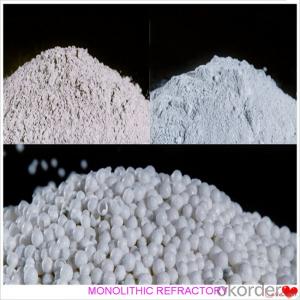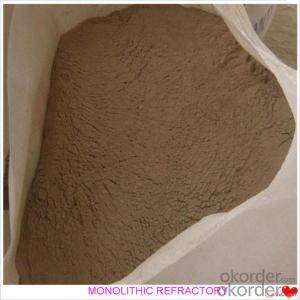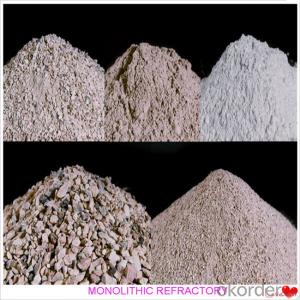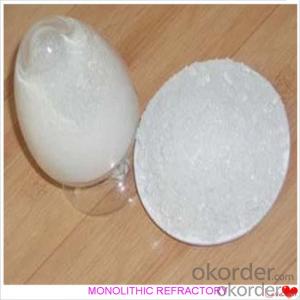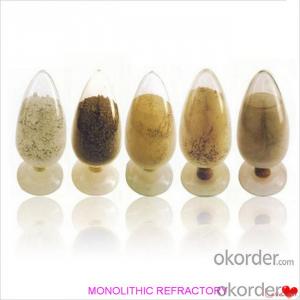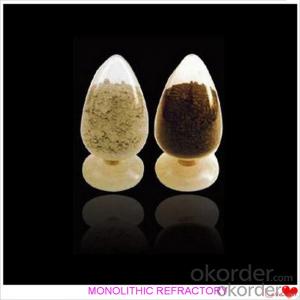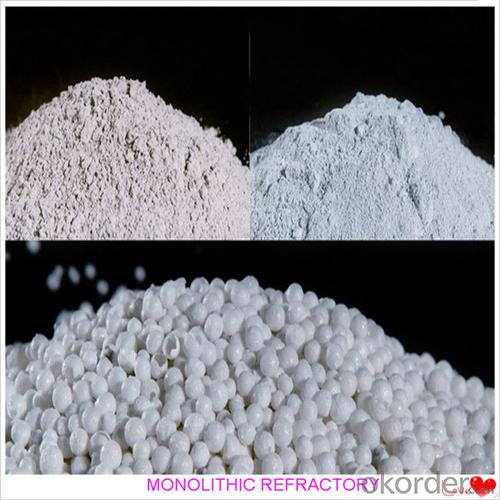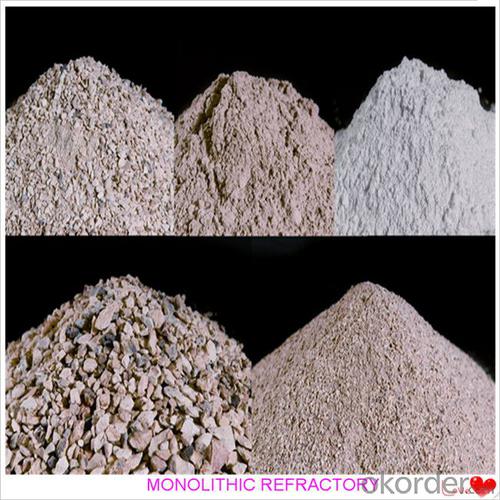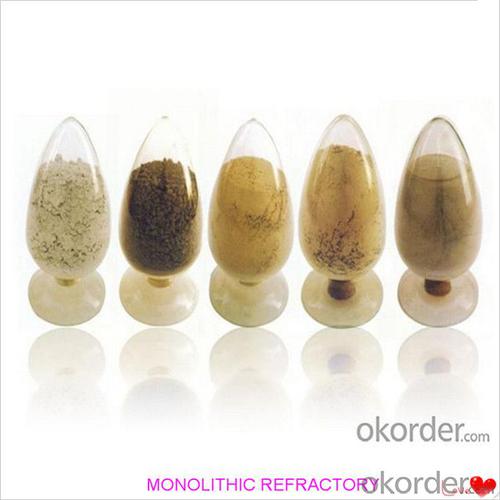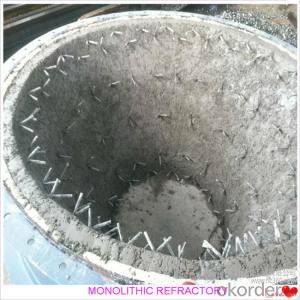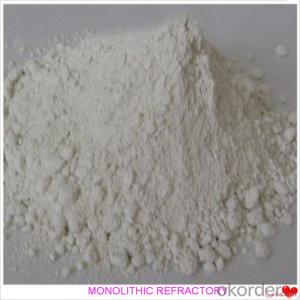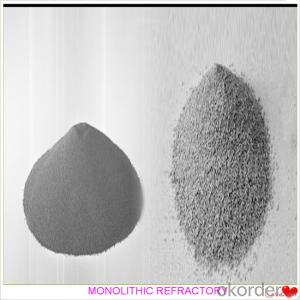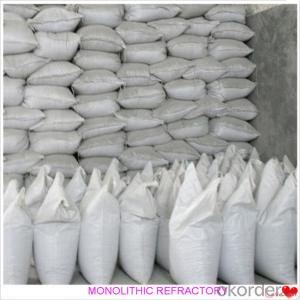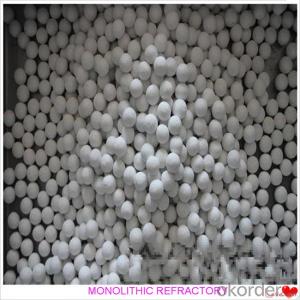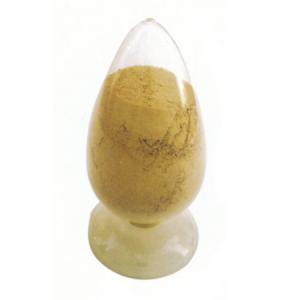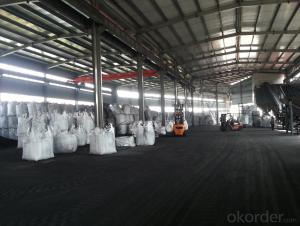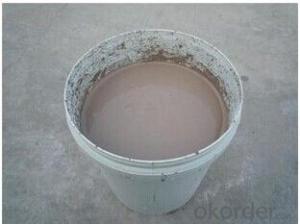Monolithic Refractories for Iron and Steel Industry - Steel Fiber Castable for Fireplace and Industrial Furnace
- Loading Port:
- China main port
- Payment Terms:
- TT OR LC
- Min Order Qty:
- 1000 kg
- Supply Capability:
- 3000000 kg/month
OKorder Service Pledge
OKorder Financial Service
You Might Also Like
Steel Fiber Castable For Fireplace and Industrial Furnace
Product Description:
Steel fiber castable is manufactured according to international standards. The product is famous for its excellent abrasion resistance and low thermal conductivity. Further, these can be provided in different specifications as required by the clients. The Steel fiber castables are used high purity raw materials and additives as the main material, and made of under superfine powder adding technology.
Product Advantages:
The material has excellent structural stability and air tightness, and has high physical and chemical properties, also has a fine working ability.They should be used with the same material products.They are widely used in various kinds of kiln lining.Such as boiler, blast furnace hot blast stove, heating furnace, ceramic kiln, etc.Furnaces of metallurgy industry, heat treatment furnace. Furnace of incineration of garbage, recirculating fluidized bed furnace. Furnaces of chemical industry and construction industry.
Product Applications:
For feature of Steel fiber castable, they have excellent abrasion resistance, thermal shock resistance, high-temperature resistance, anti-corrode and have high intensity.
Designed for refractory lining of blast furnace iron and slag runners, skimmers and soon
They can be used in troughs of small and mid size BFs and in all positions of the troughs where fast tapping is required.
Main Product Features:
1. High refractoriness, High refractoriness under load.
2. High density, low porosity.
3. Good slag resistance and corrosion resistance.
4. High strength and wear resistance.
5. Good resistance to flake performance.
6. Good thermal shock stability.
7. Scouring resistance
8. Good hot strength.
Product Specifications:
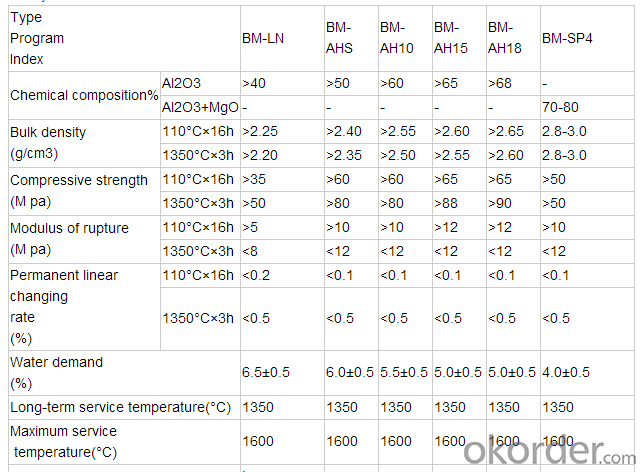
FAQ:
1. How you can control your quality?
For each production processing, we have complete QC system for the chemical composition
and Physical properties. After production, all the goods will be tested, and the quality certificate
will be shipped along with goods.
2. What's your delivery time?
It usually needs about 20days- 45 days after receiving the deposit.
3. Do you provide free samples?
Yes, we can provide a free sample for testing, If we have sample in stock,
The quantity based on the material type, The buyer should bear all the shipping costs.
4. What's your payment terms?
We can accept 30% deposit, 70% balance before shipment for ordrs over $ 2000.
5. Can we visit your Company?
Yes, certainly. You are very welcome to China and we will be honored to have a customer and friend.
Product Picture:
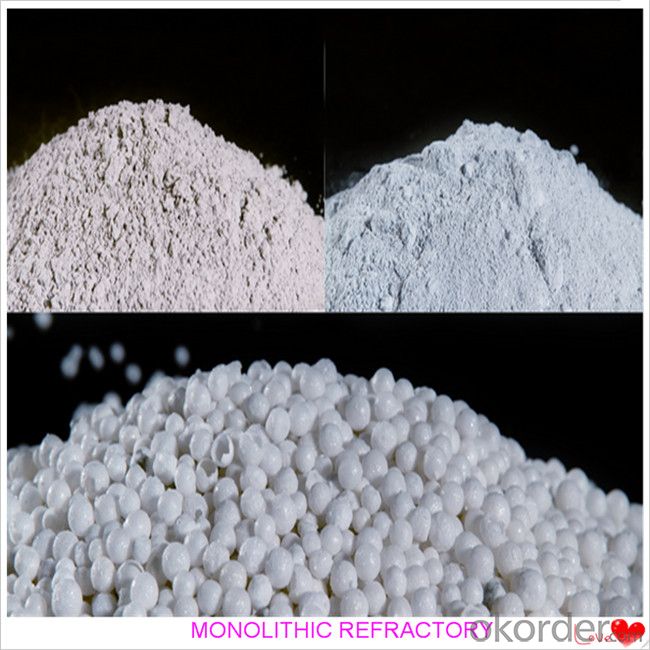
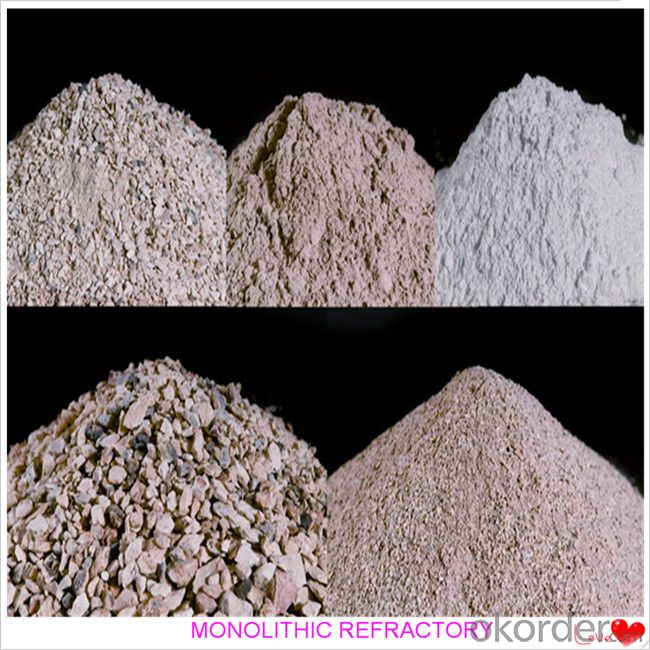


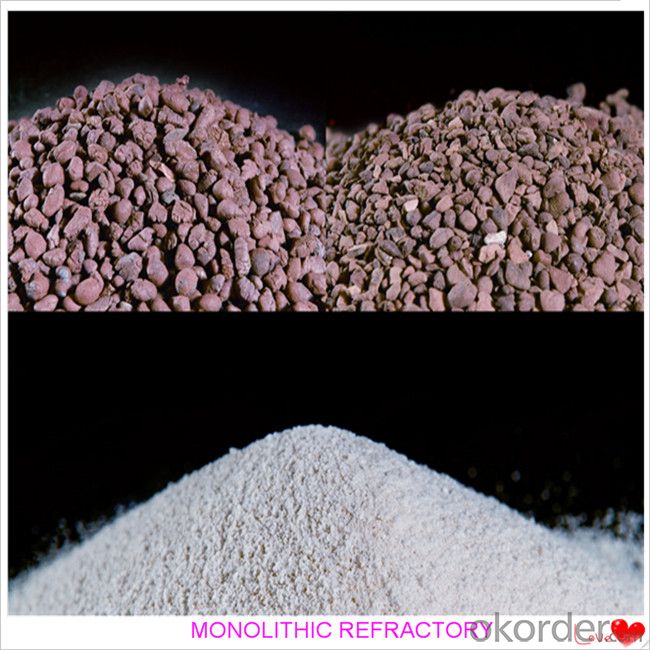
- Q: How do monolithic refractories protect lining in ladles and tundishes?
- Monolithic refractories protect lining in ladles and tundishes by forming a strong and durable barrier against the harsh conditions of high temperatures, thermal shock, and chemical corrosion. They are designed to withstand the extreme heat and mechanical stresses that occur during metal pouring and handling, ensuring the integrity and longevity of the lining. Additionally, monolithic refractories provide excellent insulation properties, reducing heat loss and conserving energy in the ladles and tundishes.
- Q: How do monolithic refractories perform in ladle lining applications in the iron and steel industry?
- Monolithic refractories are widely used in ladle lining applications in the iron and steel industry due to their excellent performance and durability. These refractories, which are made from a single material composition, offer numerous advantages over traditional brick linings. One of the key benefits of monolithic refractories in ladle lining applications is their superior resistance to thermal shock. Ladles in the iron and steel industry are subjected to extreme temperature fluctuations during the steelmaking process, including the pouring of molten metal and the subsequent cooling. Monolithic refractories are specifically designed to withstand these rapid temperature changes without cracking or spalling, ensuring the integrity of the ladle lining. In addition to thermal shock resistance, monolithic refractories also exhibit excellent resistance to chemical attack. Ladles in the iron and steel industry are exposed to highly corrosive molten metal and slag, which can degrade the lining materials over time. However, monolithic refractories are formulated with high-quality raw materials that offer exceptional chemical stability, preventing the erosion and penetration of corrosive substances. Furthermore, monolithic refractories provide superior mechanical strength compared to traditional brick linings. This is particularly important in ladle lining applications, as the lining needs to withstand the weight of the molten metal and the mechanical stresses associated with ladle handling and transportation. Monolithic refractories have excellent load-bearing capabilities, ensuring the structural integrity of the ladle lining even under heavy loads. Another advantage of monolithic refractories is their ease of installation. Unlike brick linings that require meticulous bricklaying, monolithic refractories can be installed using various techniques, such as gunning or casting, allowing for faster and more efficient lining repairs or replacements. This reduces downtime during ladle maintenance, leading to increased productivity and cost savings for iron and steel manufacturers. Overall, monolithic refractories perform exceptionally well in ladle lining applications in the iron and steel industry. Their resistance to thermal shock and chemical attack, superior mechanical strength, and ease of installation make them an ideal choice for ensuring the longevity and reliability of ladles in steelmaking operations.
- Q: How are monolithic refractories used in the repair and maintenance of ladle and tundish covers?
- Due to their excellent thermal resistance and durability, monolithic refractories are commonly utilized for repairing and maintaining ladle and tundish covers. These covers play a crucial role in the containment of molten metal and the prevention of heat loss during the steelmaking process. When exposed to high temperatures and thermal cycling, ladle and tundish covers can undergo wear and tear, resulting in cracks, spalling, or even complete failure. This is where monolithic refractories come into play. Monolithic refractories are refractory materials that are not shaped and can be easily molded and applied to damaged areas of ladle and tundish covers. They can be cast, gunned, or sprayed onto the surface, enabling quick and efficient repairs. Typically, these refractories consist of a matrix material, such as alumina, silica, or magnesia, along with various additives and bonding agents. The specific composition depends on the application requirements and severity of operating conditions. The repair process begins by identifying the damaged areas of the ladle or tundish cover. Any loose or damaged refractory material is removed, and the surface is prepared for the application of the monolithic refractory. This may involve cleaning, roughening, or even preheating the surface, depending on the specific requirements. The monolithic refractory is then mixed with water or a suitable binder to achieve a workable consistency. It is then applied to the damaged areas using the appropriate method, such as casting or spraying. After application, the refractory material is allowed to dry and cure, typically through controlled heating. Once cured, the monolithic refractory forms a robust and durable lining that can withstand the high temperatures, thermal cycling, and chemical reactions occurring during ladle and tundish operation. It provides excellent thermal insulation, minimizing heat loss and reducing energy consumption. Moreover, monolithic refractories exhibit superior resistance to slag, metal penetration, and erosion, ensuring extended service life for ladle and tundish covers. They also possess good thermal shock resistance, enabling them to endure rapid temperature changes without cracking or spalling. In conclusion, monolithic refractories are indispensable for repairing and maintaining ladle and tundish covers due to their thermal resistance, durability, and ease of application. Their ability to withstand high temperatures, thermal cycling, and chemical reactions ensures the integrity and efficiency of ladle and tundish operations in the steelmaking industry.
- Q: Can monolithic refractories be used in electric arc furnaces and induction furnaces?
- Yes, monolithic refractories can be used in both electric arc furnaces and induction furnaces. Monolithic refractories are versatile and can withstand the high temperatures and thermal shocks generated in these types of furnaces. They are often preferred due to their ease of installation, improved energy efficiency, and suitability for various furnace lining applications.
- Q: What types of monolithic refractories are commonly used in the iron and steel industry?
- Due to their exceptional resistance to extreme temperatures and mechanical stresses, various types of monolithic refractories are widely used in the iron and steel industry. These refractories play a crucial role in lining furnaces, ladles, and other equipment used in the production of iron and steel. One commonly employed monolithic refractory in this industry is castable refractory. It is a blend of refractory aggregates, binders, and additives that can be poured or cast into different shapes and sizes. Castable refractories are versatile and easy to install, making them suitable for lining large furnaces and ladles. Additionally, they offer excellent resistance to thermal shocks and provide good thermal insulation. Another type of monolithic refractory utilized in the iron and steel industry is plastic refractory. It comprises a high-alumina refractory aggregate mixed with a bonding agent, typically clay. Plastic refractories possess high plasticity and can be easily shaped by hand or with a trowel. They are commonly used for repairing and patching in furnaces and ladles. Ramming refractories are also frequently employed in the iron and steel industry. These refractories consist of granular refractory materials blended with a binder. They are installed by forcefully ramming the mixture into the desired shape using either a pneumatic hammer or manual ramming tools. Ramming refractories offer exceptional resistance to abrasion and erosion, making them suitable for lining the bottoms of furnaces and other areas subjected to intense mechanical wear. Lastly, gunning refractories find wide application in the iron and steel industry. Gunning refractories are composed of fine refractory powders mixed with water or a bonding agent. They are applied using a gunning machine, which propels the refractory material onto the surface that requires lining. Gunning refractories are commonly used for repairing and maintaining the linings of ladles, tundishes, and other equipment. In conclusion, the iron and steel industry heavily relies on a variety of monolithic refractories, including castables, plastics, rammings, and gunnings, to ensure the reliable and efficient operation of their equipment in high-temperature environments. These refractories offer outstanding thermal insulation, resistance to thermal shocks, and mechanical strength, which are essential for the production of iron and steel.
- Q: How do monolithic refractories enhance the performance of ladle and tundish preheating systems?
- Monolithic refractories enhance the performance of ladle and tundish preheating systems by providing excellent thermal insulation, high mechanical strength, and resistance to corrosion and erosion. This allows for efficient heat retention and distribution, ensuring uniform and consistent preheating of ladles and tundishes. Additionally, monolithic refractories minimize heat losses, reduce energy consumption, and increase the lifespan of the preheating systems, contributing to improved overall performance.
- Q: How do monolithic refractories improve the performance and efficiency of iron and steel production?
- Monolithic refractories improve the performance and efficiency of iron and steel production by providing superior thermal insulation and resistance to high temperatures. They help to minimize heat loss, enhance heat transfer, and reduce energy consumption during the production process. Additionally, monolithic refractories offer excellent resistance to chemical reactions and erosion caused by molten metal and slag, thus extending the lifespan of refractory linings and reducing maintenance requirements. Overall, their use in iron and steel production improves productivity, reduces downtime, and contributes to cost savings.
- Q: What are the recommended curing and drying procedures for monolithic refractories?
- The recommended curing and drying procedures for monolithic refractories typically involve a gradual heating process to ensure proper bonding and removal of any moisture. This process usually starts with a preheat at a low temperature to eliminate any residual water, followed by a controlled temperature increase over a specific duration to achieve the desired strength and stability. It is essential to follow the manufacturer's guidelines and consider the specific composition and thickness of the refractory material to ensure optimal curing and drying.
- Q: How do monolithic refractories improve the efficiency of ladle and tundish drying systems?
- Monolithic refractories play a crucial role in improving the efficiency of ladle and tundish drying systems. These systems are used in the steel industry for the drying process of ladles and tundishes before they are used for casting molten steel. One of the main advantages of monolithic refractories is their ability to provide a seamless lining, without any joints or gaps. This ensures that there are no weak points in the lining, reducing the risk of heat loss during the drying process. By maintaining a uniform and continuous lining, monolithic refractories help to achieve faster and more efficient drying of ladles and tundishes. Furthermore, monolithic refractories have excellent thermal insulation properties. They have low thermal conductivity, which means that they can effectively retain heat and prevent its transfer to the surroundings. This insulation capability allows for better heat retention within the ladles and tundishes during the drying process, resulting in faster and more energy-efficient drying. Monolithic refractories also offer superior thermal shock resistance. During the drying process, ladles and tundishes are subjected to rapid temperature changes, which can cause thermal stress and lead to cracks or spalling of the lining. However, monolithic refractories have high resistance to thermal shock, ensuring the durability and longevity of the lining. This resistance to thermal shock minimizes the need for frequent repairs or replacements, thereby increasing the overall efficiency of the ladle and tundish drying systems. In addition, monolithic refractories have good corrosion resistance. They are designed to withstand the harsh conditions and corrosive environments that ladles and tundishes are exposed to during the drying process. This corrosion resistance helps to maintain the integrity of the lining, preventing any degradation or damage that could affect the efficiency of the drying systems. Overall, the use of monolithic refractories in ladle and tundish drying systems improves their efficiency by providing a seamless lining, excellent thermal insulation, thermal shock resistance, and corrosion resistance. These properties contribute to faster drying times, energy savings, reduced maintenance requirements, and increased longevity of the equipment.
- Q: What are the key properties of pumpable refractories used for monolithic refractory applications?
- The key properties of pumpable refractories used for monolithic refractory applications include high flowability, good workability, excellent bonding strength, and high resistance to thermal shock. These pumpable refractories should also possess good pumpability and be able to withstand the intense heat and mechanical stress in the application environment. Additionally, they should have low water demand, high chemical resistance, and the ability to maintain their properties even after exposure to high temperatures.
Send your message to us
Monolithic Refractories for Iron and Steel Industry - Steel Fiber Castable for Fireplace and Industrial Furnace
- Loading Port:
- China main port
- Payment Terms:
- TT OR LC
- Min Order Qty:
- 1000 kg
- Supply Capability:
- 3000000 kg/month
OKorder Service Pledge
OKorder Financial Service
Similar products
Hot products
Hot Searches
Related keywords
